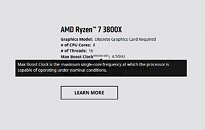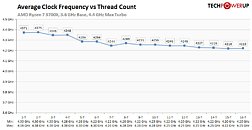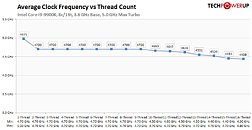Monday, August 12th 2019

AMD Updates Ryzen Product Pages to Elaborate on "Max Boost Clocks"
AMD over the weekend updated the product-pages of its Ryzen processors on the company website to be very specific about what they mean by "Max Boost Clocks," that are advertised almost as extensively as the processor's main nominal clock-speeds. AMD describes it has "the maximum single-core frequency at which the processor is capable of operating under nominal conditions." We read into this as the highest boost-clock given to one of the cores on the processor.
If you've been reading the "clock-frequency and boost analysis" charts in our processor reviews, you'll know that AMD processors spread their boost frequency progressively across cores during a multi-threaded workload that scales across all cores. At any given time, only one of the cores is awarded the highest boost clock, and while the other cores too get boosted beyond the nominal clock-speeds, they are in slight decrements of 25-50 MHz. The graph below is from our Ryzen 7 3700X review. The second graph below is from our Core i9-9900K review, which too shows only one of the cores getting the max boost frequency, and the remaining cores getting lower boost clocks, although the graph looks flatter.
Source:
squidz0rz (Reddit)
If you've been reading the "clock-frequency and boost analysis" charts in our processor reviews, you'll know that AMD processors spread their boost frequency progressively across cores during a multi-threaded workload that scales across all cores. At any given time, only one of the cores is awarded the highest boost clock, and while the other cores too get boosted beyond the nominal clock-speeds, they are in slight decrements of 25-50 MHz. The graph below is from our Ryzen 7 3700X review. The second graph below is from our Core i9-9900K review, which too shows only one of the cores getting the max boost frequency, and the remaining cores getting lower boost clocks, although the graph looks flatter.



134 Comments on AMD Updates Ryzen Product Pages to Elaborate on "Max Boost Clocks"
I don't know what AMD's definition of 'nominal' is, but it's clearly not a 240mm AIO water cooler within the winter season, because I can't achieve the rated boost frequencies on my Ryzen 9 3900X.
How about DDR4 4400MHz memory "only" managed DDR4 4375MHz, would people be happy? I think not.
The issue is as you say with the marketing, but the users have been "sold" a number and as such are expecting said number, not 200-300MHz less than said number.
How do you suggest that situation should be resolved, as it seems AMD is now trying to come up with some rather lame excuses as to why we're not quite getting what we paid for.Am I? Where does it say so? I haven't seen anything that specifies this. And the 3700X gets the same clocks by the looks of it, so what did I pay extra for that I got with my 3800X?And this is why we're here discussting this matter. A lot of people are not seeing the expected speeds, while others are getting better than the expected speeds form their CPUs.
There's been zero clarity from AMD as to why this is happening.Nor a 280mm AIO liquid cooler on my 3800X...
Maybe 360 is the magical number?
Fwiw, Intel doesn't do a much better job either:Though for Intel we can find this: en.wikichip.org/wiki/intel/core_i9/i9-9900k
so it seems it can hold that boost when one full core is under load.
Without enabled all the overclocking settings in my UEFI, I simply can't get about 4.4GHz, which is not what their specs claim.
On top of that, their PBO video claimed you can get an extra 200MHz or maybe even 300MHz out of the chips if you get the "right" motherboard, but I guess my board is simply too cheap...
Again, my system performs well, but the product I was sold, is not what I got.
So no.
Say you bought a car with a certain fuel usage and a certain performance, but it turns out you're only getting 80% of the claimed fuel usage and performance, would you be happy?
It was the model that didn't get tested by any car magazine, but you bought it based on the performance of the nearest model.
Then the car manufacturer went out and stated it was during "nominal conditions" without explaining those conditions, would you be happy?
I think not.
greetings!
The l/100km is also done under VERY specific conditions, with VERY specific behaviour that you'd never see in normal every day life.
Also, I think that this is being pushed out of proportion - I don't expect either camp to have a 100% up to scratch product (in relation to BIOS and drivers) within the first 3 months... too many variables that you cannot test for or expect...
Sadly, in today's world it feels like everyone's trying to cheat the consumers, one way or another.Never said it performs bad, but AMD threw a number in the hat and isn't meeting that number...
I paid for something that hasn't been delivered.
Am I disappointed with the performance, no.
But I would like a damned good explanation from AMD as to what has gone wrong and why so many people are seeing side a widespread performance difference (not talking MHz here, but rather actual benchmark numbers).Same on most Intel boards though, so that's not the issue.
Also, mandatory repaste due to being 1-2C below temps in Youtube review ;)I've already suggested what should be done with the 'boost' spec on a spec sheet to make it a more useful number to gauge relative performance (between CPUs of the same product line, because that's about as far as it goes anyway). I mean what else should it be other than a number you can use for at least something. If you can't, might as well remove it altogether. Its right up there with HD Ready, Watt RMS and 'dynamic contrast ratio' in bullshit stats.
As others and myself point out, you didn't buy a boost clock you bought an idea of performance and that performance is what you got. Don't get me wrong though, AMD is doing itself a service correcting this one way or the other but let's not overreact either.
Still is an interesting issue and like you I'm curious where the real problem is at. Still though if this is anything like Nvidia's GPU Boost it might just be as simple as 'losing a boost bin' just a tad earlier than most people would expect it to, which could translate to something silly as moving a temperature or voltage target up or down a notch. And maybe, just maybe, AMD concluded it can't guarantee stability if it does that. We already know these CPUs happily clock above boost if you really want them to.
And then I spotted this
wtf?
Tldr: you will reach max boost clock in limited situations.
- as AMD stated, at least one core is able to to max boost; that means that many others might not be able to do so;
- when you launch a single core load like cb you cannot control the process (or maybe you can) to be loaded on that one core that can do max boost. So most of the time you end up getting lower boost clocks because you hit a slower core, hence the problem people complain about.
I do agree that this is a problem, but I do think it is hard to make a fix since it is hard to detect what threads will use a core to 100% and then maybe migrate it to the core that can go to max boost...
The only solution is to either lower the specs or improve the process tech with tsmc so that all core can achieve min freq = max boost.
This is an enthusiast forum and I am not the average user. AMD sold me a 4.2ghz chip as a 4.6ghz chip. I average 4.2ghz when gaming or running single threaded benchmarks. I have caught the cpu running as fast as 4525mhz, but only at idle. During any kind of load no matter the amount of cores used, it does not boost that high. I knowingly purchased my 3900x knowing about these problems, but that doesn't mean they aren't problems.
AMD's XFR or boost does seem to work better than intels turbo boost. AMDs boost even seems magical given that it can overclock the cpu higher than us enthusiasts can manually do it. It is fascinating that AMD can do this. AMD marketed their cpus with this increase even. I think AMD should have sold these as 4.2ghz cpus that can boost higher given AMD's technology that you can't get in intel. This way we would be talking about how cool AMD is for giving us more performance potentially, even though the cpu doesn't really boost higher than 4.2ghz under load. The 4525mhz I get would be exciting even though it only happens at idle rather than under load when I could use that clockspeed increase.
Every Intel cpu I have purchased has been able to meet the turbo boost clock. I have also consistently been able to overclock the cpu by manually setting the cpu to run all cores at the boost speed. Intel has binned every cpu so that it can for sure run at the max boost speed. From an hardware enthusiast point of view this is valuable. We can trust Intel to have consistent as advertised performance but we can also run our cpus as fast as Intel advertised on all cores if we have the knowledge, cooling, and motherboard to do it. In contrast AMD has a theoretical boost clock as a marketing gimmick hiding behind some really cool technology.
Am I upset? Not perticularly. I knew what I was buying. I would buy it again. I still think AMD's boost clock is bad advertising and isn't worth it despite being better than intels. The problem isn't the boost algorithm but the silicone not being able to run as fast as marketed, especially when it is needed.
Try this: fire up SuperPi (single threaded) and see whether you reach the advertised speeds. If you don't, then yes, AMD has shafted you.
Most guys don't ever get close to max advertised boost clocks even when running single core loads with everything else closed .
The only way to hit advertised boost clocks is to move around the mouse when PC is idle , this is what AMD means for '' optimal conditions '' and this is where the marketing BS comes to play !
The debate here is to know if it is ethical from AMD to advertise clocks you can hit only when you play with your mouse at idle instead of advertising clocks you can hit under '' normal '' single core loads ?
The answer is hopefully obvious , hence why many peoples do rightfully so complain about not getting what they paid for !